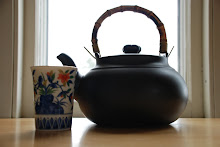
The wrapped box remained on the kitchen counter for two days. Its oblong symmetry holding the secret of its contents, its gilded ribbons drawing me in. I'd pass by it on my way to get a glass of water, shoot a furtive glance at the doorway, and then deftly take up the box in my hands, shake it a little, and be none the wiser.
My birthday came, and the license to open presents. The box came down from its roost, with E looking on. The ribbons fell in tendrils on the counter, the cardboard rustled free of its contents. I pulled forth from crinkly tissue paper a handsome clay teapot and its companion saucer. Thrown on a potter's wheel in Tunisia, they evoke a Moorish sensibility in their design and colors.
It was fitting then that I inaugurate my new teapot by brewing a black tea in it. Aromatic chai or Moroccan mint, either would be thematic with my Tunisian teapot, evoking bustling souks and their Eastern spices. Instead, I opted for the Organic Yunnan Black Tea that I have been lukewarm about in a previous post. I would give this tea yet another go; for the last several mornings, I tried drawing out latent flavors in the tea by varying brewing times, amounts of leaves used. The results were variable. On one day, the tea first burst on my palate with an astringency, followed by a complexity of other flavors. Burnt molasses? A hint of sour artichokes? But underlying all these - the scaffolding of the tea - was a blandness that I could not overlook. I really wanted to embrace the tea, to bring it into my repertory of beloved blacks where Keemun and 1st flush Darjeeling reside.
So after a quick warming of the teapot with hot water, I steeped the tea in the new teapot, scooping out three loosely packed teaspoons of leaves into 8 ounces of boiling water. This time, I brewed the tea for four minutes and twenty seconds (a new permutation in brewing time I had yet to use).
Steam swirled as I waited, the pain aux raisins (a fortuitous find from a local bakery, reminding me of past sweet-soaked days in Paris) laid out for tea. I poured the dark liquor into my cup and settled into my chair.
I wished I could say that the new teapot imbue this tea with a magical aura, supplanting its lackluster undercurrent with a robust mouthfeel. This was not the case. Nevertheless, enfolded into the moments of tea time was the essence of a cup of tea, whose leaves I envisioned plucked by hands lined with toil, this human connection infusing with warmth, my tea-filled kitchen nook.












